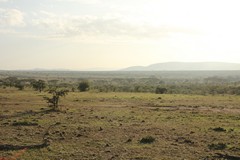
Looking across the rolling plains of the
Maasai Mara. Trees follow the stream lines
The Maasai Mara, is a large national game reserve in south western Kenya, contiguous with the Serengeti National Park in Tanzania. The whole Mara-Serengeti ecosystem covers 25000 km2. It is named in honour of the Maasai people, the ancestral inhabitants of the area. The word "Mara" means speckled in Maa and was their description of the area because of the numerous small trees that dot the plains.
You can see its position and that of the conservancies on the Mara Conservancies (map).
The Mara and conservancies is 1510 km2 in area.
The Masai Mara Ecosystem is part of the Great Lake Victoria basin. To the east the landscape is dominated by the Ngama Hills, granite and quartz rock formations created by volcanic activity. The natural northwest boundary of the Masai Mara is made up of the Oloololo Escarpment. Much of the area of the Mara and conservancies to the North is covered by open grassy savannah and rolling hills. There are several seasonal small rivers.
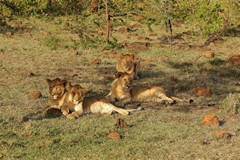
There are lots of these red brown boulders
everywhere. These are part of the Pre-Cambrian
basement. There are also a lot of lions
The Great Lake victoria basin is underlain by Cambrian and Pre Cambrian igneous and metamorphic rock, 600 million years or more old. Much of it was eroded then covered by volcanic rock from the times when the rift valley was very active.
Rainfall is around 1400mm per year, with April being the wettest month. Even though Kenya was experiencing a drought when we went it was much less marked in the west and so the Mara appeared very lush and green.
Rainfall is bimodal. Short rains in November to December, then a lull, and then longer heavier rains from late March to May. However rainstorms can occur through January and February as well. Rainfall increases as you travel from the southeast to the northwest. Wildlife concentrations are at their peak numbers in the wetter areas.
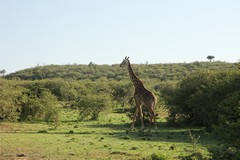
Many of the hills are covered in thickets of
plants such as croton, tarchonanthus and
acacia. They provide good cover for
carnivores
The Mara river rises in the Napuiyapi swamp in the Mau escarpment and flows 395 km through the reserve and into Tanzania.
The two other major rivers draining the Mara are the Sand, and the Talek, which eventually joins the Mara.
Vegetation in the park is mostly open savannah grassland, with shrubs and trees covering some hillslopes, and small woodland areas growing as riverine forest following the rivers.
Over 570 species of birds have been recorded within the ecosystem, including around 60 species of raptors. 95 species of mammals have been identified.
It is a big five park. Only black rhinos are present. They are scarce with maybe 35-50 at any one time in the reserve, and they travel back and forth to the Serengeti. Black rhinos are smaller than white rhinos and carry their heads much more upright. They have a hook shaped prehensile top lip which they use for browsing, and are less likely to be seen out in the open than white (square lipped) rhinos which are grazers. Black rhinos are the more aggressive of the two African rhinos. My all time favourite animals and they are critically endangered due to poaching for their horns.
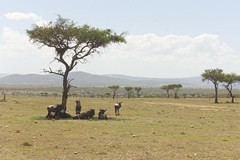
Western white-bearded wildebeeste are the
dominant larger ungulates, along with zebra,
topi and eland
There are lots of elephants, buffalos, lions (Naboisho has one of the highest densities in the world), cheetah (Ol Kinyei has one of the highest cheetah densities in the world), leopards, and zebras, wildebeeste, topi, eland, waterbuck, bushbuck, Grant's and Thompson's gazelles, and many more.
African hunting dogs are occasionally seen but are quite rare due to transmission of canine distemper and too much competition with lions.
The beauty of the conservancies is that they are private, and so access is stricltly limited to vehicles from camps within the conservancies and these are very few so it's just not busy. It is easy to feel that you are far from civilisaton. No crowds around lions or leopards. Often you have the sighting to one car only. Also there are no restrictions about off roading.
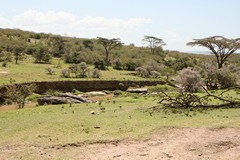
Many small rivers cut through the attractive
hilly parts of the conservancies. The wider
ones are home to hippos and crocodiles
Ol Kinyei conservancy is a superb location from which to observe the Serengeti Wildebeest Migration (generally in the Mara from June to October), and there is another Wildebeest Migration which comes in from Kenya’s Loita Plains, moving into Ol Kinyei Conservancy earlier, usually by January. The annual wildebeest calving takes place here during February and March when the plains are teeming with wildebeest before they move on through Naboisho Conservancy and into Olare Motorogi and the Mara proper.
Naboisho was formed from a conglomeration of 500 Maasai landowners, and the name means "coming together" in the Maa language.
The Mara Naboisho Conservancy is the second largest of the Greater Mara’s conservancies, (Mara North is the biggest), and one of the most beautiful. The Ngama Hills rise in the distance, streams run across the open grassland and acacia trees dot the landscape, The conservancy has the big cats in big numbers.
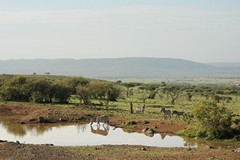
A waterhole in Naboisho
Some of the problems facing the Mara include, long term increases in temperature and decrease in rainfall for the area, brought about by climate change.
Overgrazing of livestock can not only mean increased competition for food, but also a decrease in natural prey for carnivores. This leads to increased attacks on livestock and subsequent retaliation (killing) of predators. To combat this some conservancies have set up zones where livestock can be grazed for certain periods, and then rotated out. Conservancies generally provide a cash source alternative to landowners thanks to eco tourism and work very well in terms of conservation.
Loss of forest due to increased demand for charcoal for cooking as the population expands. This can seriously upset buffer zones, which are constantly being eroded as land is claimed for other uses. Also migration routes are being closed off.
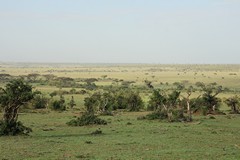
Vast open tree dotted plains. The beauty of
the conservancies is that there is very little
traffic to spoil the tranquility
There is also the endemic problem of bushmeat poaching, often with snares that are totally indiscriminate and cause untold suffering for wildlife.
I could write huge amounts more, and much of this applies to most parks in Africa, but I suggest you do your own research if you are interested.
Overall the Mara Conservancies are superb places to go and observe wildlife. They are very species diverse and are also blessed with beautiful varied scenery which makes them a paradise for photography. It's easy to get to the Mara proper for a day safari as well. The conservancies are also very peaceful and add to the overall experience of being in the bush.
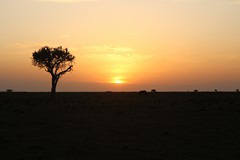
The end of the day, time for sundowners
The Mara itself is also pretty awesome, as I remember from a visit a long time ago. The downside is the vastly increased traffic which always spoils the ambience for me. There is an advantage to this extra traffic though - there are a lot more pairs of eyes spotting game so the chance of seeing a rhino or leopard is very much improved. I doubt that there are any rhinos in the conservancies.
Furthermore you need to get down to the Talek or Mara rivers to observe a 'crossing' where hundreds or thousands of wildebeeste, zebras and others risk the legendary crocodiles teeth to get to the other side for better grass.
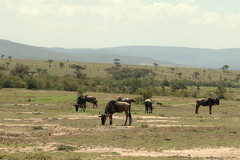
Wildebeeste must be the iconic animals of
the Maasai Mara
Remember these huge herds only cross when the migration is in the area between around July to October. Timings can vary a little from year to year. Research is vital if a crossing is a 'must see'.